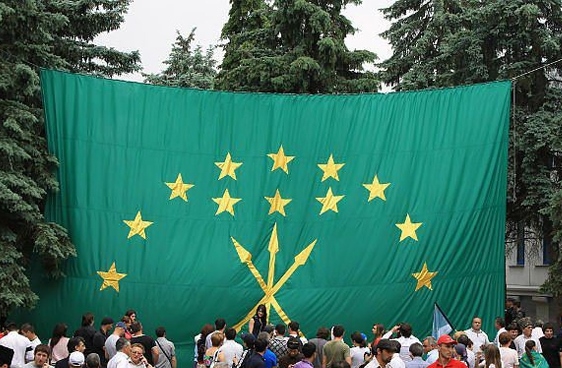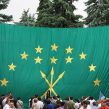
Circassian Military Traditions Still Keeping Diaspora Strong
Publication: Eurasia Daily Monitor Volume: 10 Issue: 115
By:

The 500,000 Circassians in the North Caucasus have long drawn strength and encouragement from the continuing vitality of the 5-million-strong Circassian diaspora in the countries of the Middle East. A major source of the diaspora’s strength in turn has been the participation of many of its members in the military and security services of those countries. And that unique niche, one reflecting the way in which the Ottoman Empire treated the Circassians more than a century ago, has both reinforced the military traditions of the Circassians themselves and ensured they have powerful allies in places Moscow cannot ignore.
The reasons the Circassians living in the Middle East have maintained their collective identity so well for so long have fascinated Circassians living in their homeland. Almost a decade ago, a Kabardinian scholar, Anzor Kushkhabiyev, suggested that it reflected the size of the diaspora, the formation of relatively compact mono-ethnic settlements, the privileged position of Circassians in many of these societies, and the Circassians’ lack of religious fanaticism (A.V. Kushkhabiyev, “Faktory sokhrannosti etnokulturnoy spetsifiki i problema assimilyatsii zarubezhnoy cherkesskoy diaspory,” Istorichesky vestnik Institutat gumanitarnykh issledovaniy KBR I KBNTs RAN, Nalchik, 2005, vyp.1, pp. 100–117).
Undoubtedly, all of these factors have played a role, but now, another Circassian scholar, Anzor Ostakhov, suggests that there is a more powerful force that explains why the Circassians have maintained a strong sense of national identity. That factor, he says, is the way in which “the Ottoman authorities used the Circassians as a military-service stratum, analogous to the Cossacks [in the Russian Empire] for the preservation of state borders” and allowed them to live in their own mono-ethnic villages (kavkazoved.info/news/2013/06/06/puti-etnokulturnoj-sohrannosti-i-problema-assimiljacii-cherkesov-v-stranah-blizhnego-vostoka-i.html; kavkazoved.info/news/2013/06/07/puti-etnokulturnoj-sohrannosti-i-problema-assimiljacii-cherkesov-v-stranah-blizhnego-vostoka-ii.html).
The Ottomans used the Circassians in this way because the Circassians had proven their worth in the 101-year-long fight against Russian expansion into the Caucasus, Ostakhov says; but precisely because the Ottomans did so, the Circassians were forced to draw on that tradition and in fact “reanimate” many traditional institutions of Circassian society that otherwise could have been lost. Their success in fighting the enemies of the Ottoman state “won them uncontested authority in the entire Middle East,” he adds, and “over time, the local peoples, recognizing the danger and lack of prospects of an armed struggle with the Circassians passed over to peaceful relations with them.”
Between 1864, when the Circassians were expelled from their homeland by Tsarist Russia, and 1910, more than 150 Circassians rose to the rank of general or its civilian equivalent in the Ottoman Empire. That tradition has continued, with numerous Circassians at the top of the military and security agencies of Turkey, Syria and Jordan. Furthermore, despite their Islamic faith, Circassians have served with distinction in the Israeli military, albeit at lower ranks. Such military success has been a source of pride, Ostakhov continues, and has reinforced the importance of Circassian culture and identity for that community.
Equally important, the Circassian scholar observes, were the mono-ethnic villages where Circassians, when they were not involved in combat, could draw on the strength of their community rather than having it undermined by the presence of others. But today, according to Ostakhov, this situation is changing and working against the Circassians. While many still follow military careers, ever more Circassians move from villages to cities and are going into business, losing their language, and inter-marrying with members of other communities. As a result and for the first time, the scholar says, an increasing number of Circassians are assimilating, a shift that ultimately will affect their military roles and identities.
In Turkey, for example, the number of Circassian villages has declined from approximately 1,000 in the 1960s to only 700 now. And in Jordan, urbanization of the Circassians was an unexpected result of the 1967 Six-Day War, Ostakhov points out. In its wake, more than a million refugees flooded into Jordan, many of whom wanted to buy land. Circassian agriculturalists took advantage of the rising prices, sold to the newcomers, and moved to the cities. That, in turn, has led to a sharp increase in the number of inter-ethnic marriages and a sharp decline in the share of the younger generation that speaks their national language. According to one study Ostakhov cites, “no more than 20 percent” of Circassian children now speak it.
As a result, the Circassian diaspora is now threatened by social forces that are destroying ethnic minorities around the world. Over time, that may make this community less important for the Circassians in the homeland. But for the immediate future, the 5 million Circassians in the Middle East and their ties with military and security elites there will continue to make them important allies for the Circassians for a national homeland in the North Caucasus. Indeed, the threat of assimilation could make them, as it has other diaspora groups, even more interested in such a homeland than would otherwise be the case.




